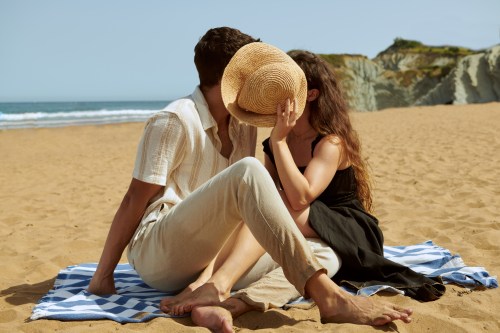Our editors independently select these products. Making a purchase through our links may earn Well+Good a commission
The world’s come a long way since relationship-status structures were limited to just a few available boxes you could select on Facebook (single, in a relationship, married). While it can be argued that the “it’s complicated” option hinted at nontraditional setups, people are increasingly using non-monogamy relationship structures to describe their still-completely-fulfilling unions. And, actually, it’s really not complicated. “Now more than ever, folks are realizing that their relationship structure and style can evolve over time as their needs, wants, and ideals change,” says sex educator and advocate Lateef Taylor. And often, that doesn’t include monogamy in the traditional one-to-one, no-exceptions sense.
Such was the case for Marlo, a queer cisgender woman, and Archer, a trans man. They met at a rugby practice for the social league in which they both participated five years ago and became fast friends. After about a year of knowing each other (which included some serious sexual compatibility and one particular drunken night), they began dating exclusively. And while they’ve been together ever since, they ditched the exclusivity concept long ago to try on various non-monogamy relationship styles, including a number of forms that fall under the umbrella of polyamory—sexually open but romantically closed, non-monogamous, open, primary partners, and being in a throuple.
“Exploring different relationship styles can be really liberating for people,” says Taylor. But how, exactly, does one start that exploration with a partner? Marlo and Archer say their origin point was after Archer cheated on Marlo. The infidelity led to a pause in the relationship, and when the two ultimately came back together after a few months, it was with eyes and minds wide open.
“We decided to give monogamy another shot, but once we’d re-built trust within that monogamous relationship, we were able to be honest with each other about our extra-relationship desires,” says Marlo, who, despite never having cheated on Archer, claims to also have a lingering eye. “I realized that Archer desiring other people and me being attracted to other people didn’t have to be a threat to our relationship so long as we made room within our relationship structure for that attraction.”
“Monogamy isn’t the only type of relationship structure available to you. The key is figuring out which will bring you (and your partner) the most joy.” —Lateef Taylor, sex educator
So after a lot of talking, many therapy sessions, and some serious research into how non-monogamy relationship structures may look, they entered into an open relationship. Taylor says “open” can mean something different for different couples, but for Marlo and Archer, it meant being free to be sexual with people outside of the relationship.
After a few months, though, “’open’ stopped feeling right,” says Archer. “It felt like a descriptor of our relationship as opposed to an identity.” Polyamorous seemed like it might fit better semantically, so that’s what they decided to try—and it stuck. Taylor notes that “polyamorous” can also mean different things to different people, and for Archer and Marlo, it’s meant being open to all relationships, including those that are purely sexual, those that are more-so romantic, and those that are a combination of sexual and romantic. “It means that I’m interested in building relationships with people in a way that feels best for that individual relationship—and not putting walls up because I’m already in a relationship with Marlo,” Archer says.
For Marlo, it means “holding every relationship I have to a really high standard, and being intentional with how I show up to all of my relationships and how I ask those people show up for me.” It’s not so much sex-based as rooted in the freedom to explore a curiosity she feels toward other people. The benefit, Marlo says, is not feeling closed off to connection for fear that a romantic or sexual spark might ignite.
Within the scope of their polyamorous relationship, Marlo and Archer have identified their partnership using several other structures. For example, a job relocation forced them to live separately for a seven-month period, and during that time, they were committed to each other on the weekends, but during the week, they were free to date and dedicate time to other partners and prospects.
More recently, they tried a throuple relationship structure. What started as a friendship turned into a threesome one fateful night, and the relationship evolved from there. “We didn’t anticipate that we would try being a throuple, but it was really great to see how someone else could make the other happy, as opposed to knowing that in a more abstract way,” says Marlo.
And though neither Marlo nor Archer can be sure about what language they’ll use to describe their relationship in years to come, they agree that being polyamorous has made them happier and healthier as a couple and as individuals. “I feel that I get to be more myself now than I did while I was in a monogamous relationship,” Archer says.
Here’s the thing, though: “No matter how you and your partner identity, that relationship is going to fluctuate and change over time,” says Taylor. So if you’re interested in exploring and expanding your own relationship structure? Start researching. “The best place to start is to get a better understanding of what you might want your relationship to look like, and then sharing that information with your partner in a thoughtful way.” To help you actually achieve that understanding, Taylor recommends consulting Dean Spade’s essay For Lover’s and Fighters and More Than Two by Franklin Veaux and Eve Rickert. From there, keep an open mind and open communication lines.
“Monogamy isn’t the only type of relationship structure available to you,” Taylor says. “The key is figuring out which relationship structure will bring you—and your partner—the most joy.”
Check out what happened when one writer fell for a guy who “didn’t do monogamy”. Oh, and if you’re already in an open relationship please disclose that to someone before taking them on a date.
Sign Up for Our Daily Newsletter
Get all the latest in wellness, trends, food, fitness, beauty, and more delivered right to your inbox.
Got it, you've been added to our email list.











